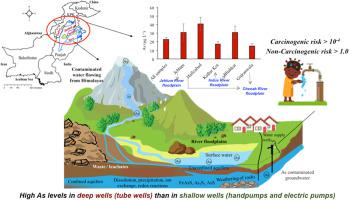Journal of Hazardous Materials ( IF 12.2 ) Pub Date : 2020-09-23 , DOI: 10.1016/j.jhazmat.2020.124074 Natasha , Irshad Bibi , Muhammad Shahid , Nabeel Khan Niazi , Fazila Younas , Salman Raza Naqvi , Sabry M. Shaheen , Muhammad Imran , Hailong Wang , Khalid Mahmud Hussaini , Hua Zhang , Jörg Rinklebe

|
The current study delineated the distribution, (hydro)geochemical behavior and health risk of arsenic (As) in shallow (depth<35 m; handpumps and electric pumps) and deep (depth>35 m; tube wells) aquifers in five areas along the Indus River (Bhakar, Kallur Kot), Jhelum River (Jhelum) and Chenab River (Hafizabad, Gujranwala) floodplains of Punjab, Pakistan. Relatively, greater As concentration was observed in deep wells (mean: 24.3 µg L-1) compared to shallow wells (19.4 µg L-1), with groundwater As spanning 0.1 to 121.7 µg L-1 (n=133) in three floodplains. Groundwater from Hafizabad (Chenab River floodplain) possessed the highest As (121.7 µg L-1), Na2+ (180 mg L-1), Ca2+ (95 mg L-1), Cl- (101 mg L-1) and SO42- (1353 mg L-1) concentrations. Arsenic health risk modeling indicated the potential carcinogenic (value>10-4) and non-carcinogenic (hazard quotient>1.0) risks for groundwater of all areas, with the utmost risk estimated for Chenab floodplain and deep aquifers. Positive saturation index values for Fe oxide mineral phases may suggest their potential role in As mobilization/sorption in these aquifer environments. This study provides critically-important and baseline knowledge for a widespread groundwater As/quality examination along these three floodplains, which is vital for launching suitable As mitigation/remediation programs to reduce the health risk.
中文翻译:

巴基斯坦旁遮普邦不同洪泛区浅层和深层含水层中砷的水文地球化学和健康风险评估
当前的研究描述了沿沿线五个区域的浅层(深度<35 m;手泵和电动泵)和深层(深度> 35 m;管井)含水层中砷(As)的分布,(水)地球化学行为和健康风险。巴基斯坦旁遮普邦的印度河(Bhakar,Kallur Kot),Jhelum河(Jhelum)和Chenab河(Hafizabad,Gujranwala)洪泛区。相对,在深井(平均:24.3微克L时观察到的更大的As浓度-1)相比浅井(19.4微克大号-1),与地下水为跨越0.1至121.7微克大号-1(Ñ = 133)在三个洪泛区。哈菲扎巴德(Chenab河洪泛区)的地下水具有最高的As(121.7 µg L -1),Na 2+(180 mg L -1)),钙2+(95毫克的L -1),氯-(101毫克的L -1)和SO 4 2-(1353毫克的L -1)的浓度。砷健康风险模型表明潜在的致癌性(值> 10 -4)和所有地区地下水的非致癌性(危险商> 1.0)风险,其中最大的潜在风险是Chenab洪泛区和深层含水层。氧化铁矿物相的正饱和指数值可能表明它们在这些含水层环境中的砷动员/吸附中的潜在作用。这项研究为沿这三个洪泛区的广泛的地下水As /质量检查提供了至关重要的基础知识,这对于启动适当的As缓解/补救计划以降低健康风险至关重要。











































 京公网安备 11010802027423号
京公网安备 11010802027423号